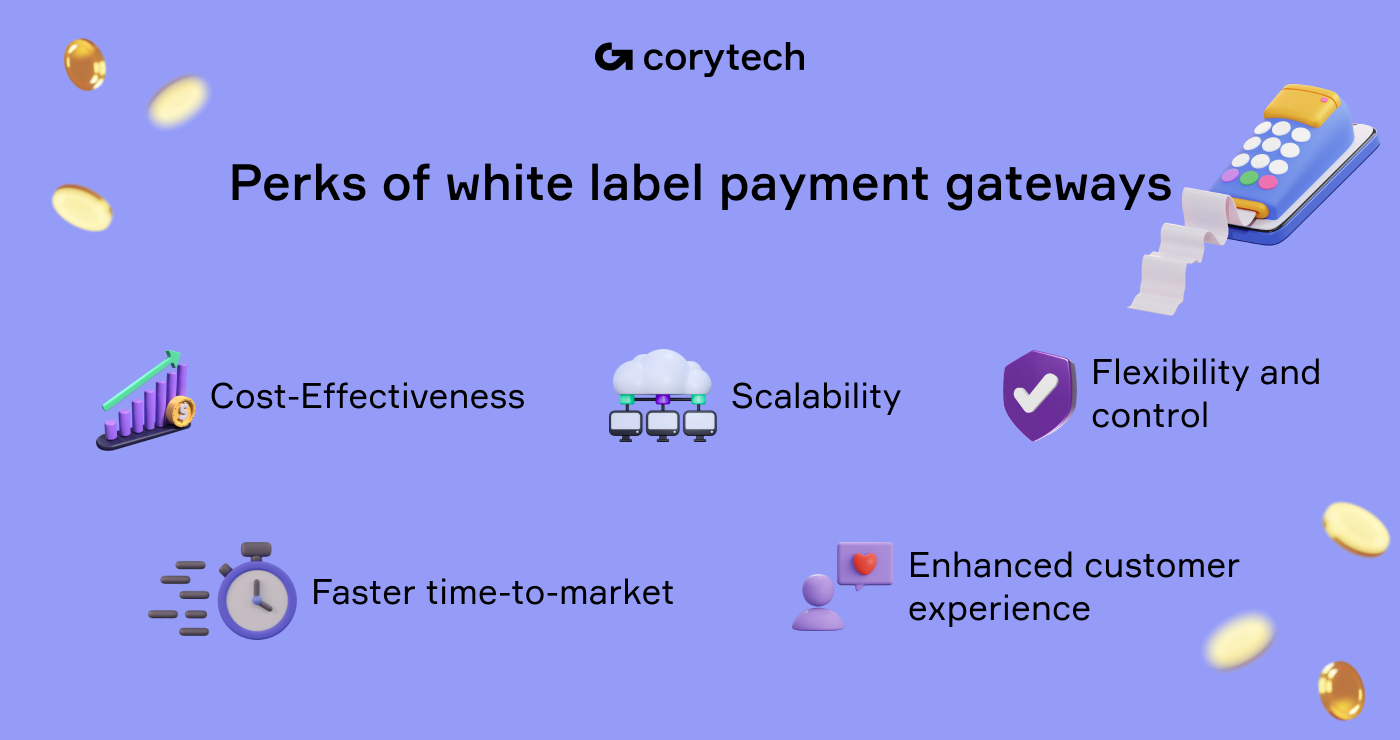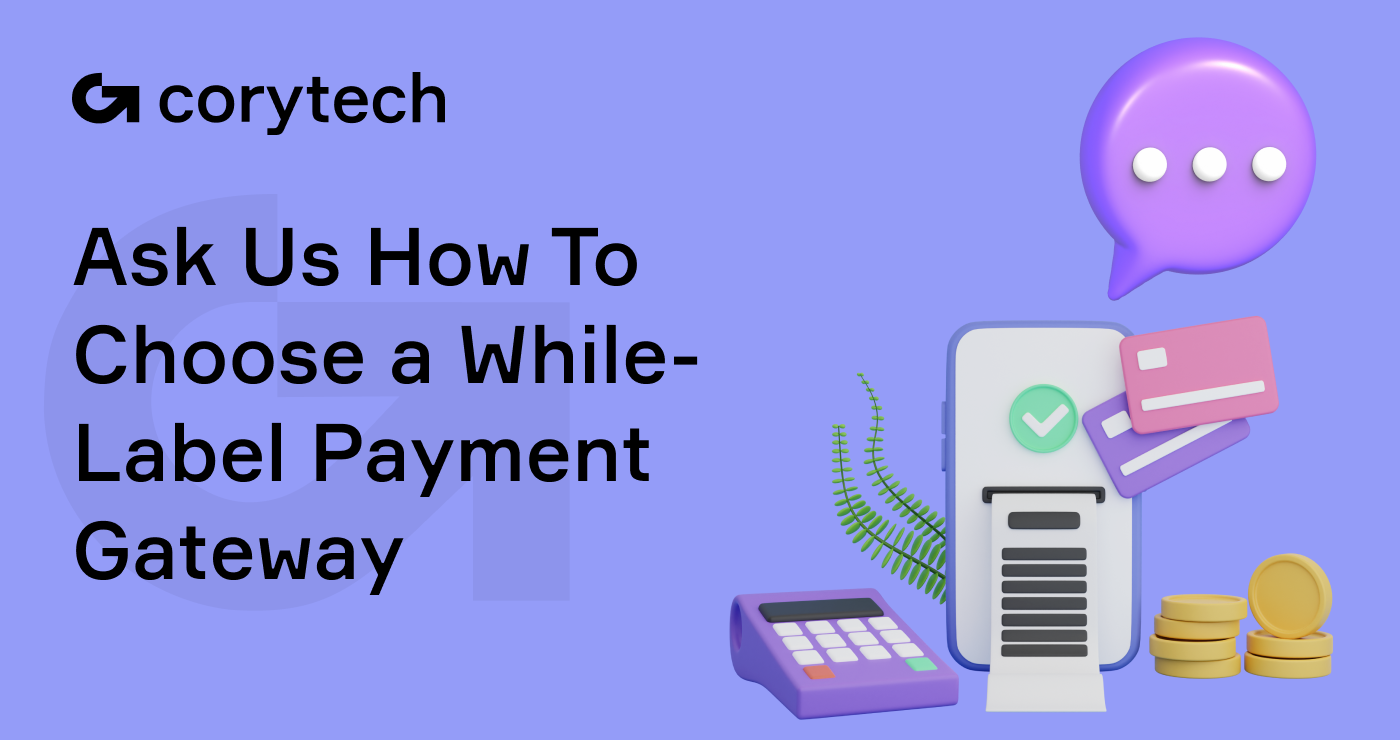Newfangled vendors need a recompense gateway, a virtual portal where shoppers can securely punch in their payment info to execute transactions on their eCommerce sites. But, plain old gateways come with a one-size-fits-all checkout process. Enter white-label payment withdrawals, allowing businesses to jazz up their checkout process with their unique logos, names, and style components without starting from scratch. Plenty of white-label payment getaway providers now offer white-label checkout tools or open-source software. It gives developers the freedom to customize the checkout process to their heart's content. In some cases, companies even specialize in crafting products solely for white-label use.
The best white-label payment gateways are all the rage in the digital world, and our goal in this article is to provide an in-depth understanding of their features and benefits. We want to show readers how these solutions work and how they can help businesses stand out in the up-to-the-minute landscape.
White-label VS Traditional Payment Gateways
White-label payment outcomes go head-to-head with traditional payment alternatives, but how do they stack up? Let's take a closer look.
When it comes to payment processing, traditional solvents offer a one-size-fits-all approach, leaving little room for customization. However, white-label online payment gateways let businesses break the mold, adding their own unique flavor to the payment process. This allows businesses to stand out in a sea of competitors and create a memorable payment experience for their customers in numerous countries.
Moreover, traditional variants often require businesses to develop their payment processing system from scratch, which can be a daunting and time-consuming task. On the other hand, white-label financial types let businesses skip the hassle and get straight to branding the payment experience.
Traditional withdrawals securely send your payment card data to a payment processor for authorization whenever you make a purchase online or swipe your card. The transaction info is then sent to credit card networks, which forward it to your bank. The bank's response is then sent back to the gateway. These alternatives have various tools and interfaces that allow merchants to collect transaction info in different ways, like through APIs for websites, business software, and mobile apps.
So, white-label payment gateway solutions are a bit more complex, but here's the gist: they let you process payments under your own brand name using third-party services. You just need to put your logo on top of it.
Key Highlights of White Label Payment Gateways
These new systems come packed with a range of aspects that set them apart from traditional revenue alternatives. Here are some key traits that make white-label payment gateway solutions a popular choice for businesses:
Customization and Branding
This financial technology enables businesses to brand the payment experience with their logos, colors, and other design elements. This helps businesses create a cohesive brand identity and deliver a memorable payment experience for their customers. Businesses that offer multiple third-party services or products that complement each other can benefit greatly from using a white-label repayment solution. For instance, an Independent Sales Organization that resells merchant accounts from banks, card terminals, and e-commerce platforms can increase its brand presence and awareness across multiple channels by using a branded funding gateway.
Seamless Integration
Integrating white-label payment gateways into existing systems can be as easy as pie, thanks to their customizable APIs and plug-and-play capabilities. According to Forbes Magazine, Stripe is valued at $115 billion in “secondary market” transactions. It offers a white-label payment withdrawal that can be easily integrated into a merchant's website or application, allowing them to accept payments without having to build their own payment processing system from scratch. With Stripe's API, merchants can customize the checkout experience to match their brand, and developers can easily add payment processing capabilities to their existing software. It's a win-win situation that allows businesses to hit the ground running with a payment gateway that fits like a glove.
Multiple Payment Methods
The preferred payment method of global up-to-date shoppers is eWallets (36%), followed by credit cards (23%) and debit cards (12%). This means that customers can choose the payment method that suits them best, and merchants can provide a seamless checkout experience. For instance, imagine you run a small clothing store and use a white-label payment gateway to process transactions on your website. Your customers can pay with their credit or debit cards but also have the option to use digital wallets like PayPal or Venmo. Business use of the cards is expected to grow by over 90 percent through the next few years, and usage is anticipated to surpass $1.6 trillion by the end of the year 2023. This way, you can cast a wider net and reach more customers, while also ensuring a hassle-free payment process. With a white-label payment option, you can have your cake and eat it too!
Advanced Security
When it comes to payment processing, white-label payment alternatives don't play around with security. They go above and beyond to protect customers' payment information from fraudsters and other malicious actors. They use state-of-the-art security measures like encryption and fraud detection, which help to safeguard sensitive data from unauthorized access. Encryption jumbles confidential data, such as credit card numbers, making it indecipherable to hackers. Meanwhile, fraud detection tools raise red flags on suspicious activity like multiple transactions in a short period, which might indicate fraudulent activities. Two-factor authentication is another advanced security feature that some white-label payment gateways provide to beef up security. With such security measures, businesses and their customers can transact with peace of mind. A brand example of a white-label payment option that provides high-level security is PayPal.
Comprehensive Reporting and Analytics
Here is a table outlining the differences between the reporting and analytics tools offered by traditional payment choices and white-label payment gateways:
|
Reporting and Analytics Tools |
Traditional Payment Gateways |
White-Label Payment Gateways |
|
Transaction Reporting |
Yes |
Yes |
|
Settlement Reporting |
Yes |
Yes |
|
Chargeback Reporting |
Yes |
Yes |
|
Refund Reporting |
Yes |
Yes |
|
Real-time Dashboard |
Limited |
Yes |
|
Customizable Reporting |
Limited |
Yes |
|
Data Visualization and Analytics |
Limited |
Yes |
|
API Access |
Limited |
Yes |
White-label payment gateways offer more advanced reporting and analytics tools than traditional payment equivalents. List of features provided by white-label payment gateways:
- Standard transaction reporting
- Settlement reporting
- Chargeback reporting
- Refund reporting
- Real-time dashboards
- Customizable reporting
- Data visualization Analytics
These tools allow businesses to gain deeper insights into their transaction data and make data-driven decisions to improve their business operations. Furthermore, white-label payment gateways also provide API access, which enables businesses to integrate the payment data with their other systems and applications, providing even more opportunities for analysis and optimization.
Global Support
White-label payment recourses have got you covered when it comes to international transactions. They speak the language of money, supporting multiple currencies and languages. So, no matter where your customers are from, they can make payments in their preferred currency and language. This helps businesses expand their customer base and reach new markets. One example of a white-label payment option that supports multiple currencies and languages is Akurateco. This payment choice supports over 100 currencies and various payment methods, making it a versatile and convenient option for businesses looking to expand globally.

Perks of White Label Payment Gateways
Cost-Effectiveness
Out of all the obtainable choices, a white-label payment recourse can be accurately labeled as the most cost-effective expenditure outcome. This is due to the fact that you are paying for pre-built usefulness with advanced features without investing in its development and upkeep. In other words, you get a lot of bang for your buck without breaking the bank.
Faster Time-to-Market
White-label payment variants offer a significant advantage of a speedy time-to-market. The duration of going live, depending on the branding, technology, and integration requirements, can take between a week to a month. In contrast, developing a compensation option on your own would take at least six months to start functioning.
Scalability
White-label payment discretions are designed to be scalable, which means they can easily adapt to the changing needs and growth of a business. As the number of transactions and customers increases, the system can handle the additional volume without any significant changes to the infrastructure. Additionally, white-label alternatives offer flexible pricing models, allowing businesses to pay for the favors they need and adjust their plans as they grow. This means that businesses can avoid the high costs and complexities associated with building and maintaining their own payment-handling infrastructure as they expand their operations. With a white-label repayment preference, businesses can focus on growth and shopper satisfaction, knowing that their cost computation needs are taken care of.
Enhanced Customer Experience
White-label technology offers a seamless and user-friendly revenue experience by providing a simple and intuitive interface for vendees to make payments. This know-how integrates with various funding methods, making it easy for customers to use their preferred revenue option. Additionally, they employ advanced security measures to ensure safe and secure transactions. By offering a hassle-free expenditure experience, white-label alternatives can augment customer contentment and improve the overall shopping experience. This, in turn, can lead to enhanced client loyalty and repeat business.
Flexibility and Control
White-label payment gateways offer more flexibility and control to businesses than conservative expense explanations. This means that businesses can customize their compensation option to suit their needs, such as branding, funding methods, and security elements. Additionally, businesses can easily add or remove payment methods as needed, without having to go through a lengthy process with a third-party provider. This flexibility and control allow businesses to create a payment experience that is unique to their brand, leading to increased buyer delight.
Picking the Right White Label Payment Gateway: Corytech’s Advice
Evaluate customization options
Make certain that the white-label payment gateway you pick has enough customization options that can match your brand identity, and help you create a smooth user experience. You should look for highlights such as customizable payment pages, checkout flows, and email templates that you can customize as per your business requirements.
Compare pricing and fees
Resemble the pricing structures of distinct white-label payment variants, including the fees for setup, transaction, and other related costs. Ensure that the chosen gateway provides a competitive pricing scheme without sacrificing quality or important attributes.
Assess security measures
Select a white-label charging variant that emphasizes security and implements industry-standard encryption while adhering to relevant compliance requirements like PCI-DSS. Additionally, the gateway should provide extra security markers such as fraud detection and risk management tools.
Check integration options
When selecting a white-label payment alternative, search for a key that easily integrates with your current systems, such as your e-commerce platform or accounting software. Make sure the gateway provides well-documented APIs and SDKs that enable smooth integration.
Review payment methods
Be certain that the white-label payment variant you prefer supports various compensation methods, such as credit cards, debit cards, digital wallets, and other alternative earnings options. This way, you can provide options that appeal to a broad range of customers.
Consider global capabilities
When choosing a white-label payment option for an international business, consider options that support various currencies and languages. This will make cross-border transactions smoother and appeal to a worldwide audience.
Evaluate customer support
Determine a white-label repayment withdrawal provider that provides dependable and prompt customer support, which includes training, documentation, and ongoing assistance. This will guarantee that you have access to help whenever you need it and can address any issues swiftly.
Test the user experience
Make sure to try out the user interface and gain the flow of a white-label payment option before finalizing your decision. This will ensure that the experience is smooth, easy to use, and secure for your customers, leading to higher customer redress and fewer abandoned transactions.
Check scalability
Select a white-label payment alternative that can adapt to your business's growth effortlessly. It should be capable of managing larger transaction volumes and providing functionalities that address the changing demands of your business.
White Label Payment Gateway FAQ
Are Stripe and Akurateco white-label payment gateways?
Yes, both Stripe and Akurateco offer white-label payment solutions. Stripe provides an extensive set of APIs and tools that enable businesses to create a fully customized financial alternative under their brand. Similarly, Akurateco offers a white-label charging technology that can be tailored to a business's specific requirements.
How much does it cost to use a white-label payment gateway?
The outlay of using a white-label payment variant varies depending on the provider and the components offered. Some providers charge a setup fee, while others offer their assistance for free. The main cost associated with using a payment choice is usually the transaction fee, which is a percentage of the transaction amount. Businesses should consider other associated costs, such as chargeback and monthly maintenance fees.
How does a white-label payment gateway work?
A white-label payment technology allows businesses to offer payment refinement assistance under their own brand. The gateway know-how handles the transaction's payment action and security aspects, while the business retains control over the user interface and customer experience. When a customer makes funding, the payment gateway securely processes the transaction and transfers the funds to the business's merchant account. The recompense gateway vendor also offers various traits, such as fraud detection and risk management tools, to ensure secure and smooth transactions.
What’s Next?
White-label payment gateways are crucial in the digital world, offering businesses a flexible, scalable, and affordable wage-handling resolution with extensive customization options, multiple financial methods, and secure transactions. By using a white-label payment option, businesses can enhance their payment calculation capabilities, provide a seamless and user-friendly expenditure experience, and amplify customer complacency.
As such, businesses should consider employing white-label payment alternative variants to improve their payment processing operations. To achieve this, they can turn to Corytech, a fully-featured platform that offers innovative waging solutions. Interested businesses can request a personalized demo from Corytech to see how it can help them streamline their payment processing operations.








 Payments
Payments
 Solutions
Solutions
 Industries
Industries
 Services
Services
 Resources
Resources

.png)










